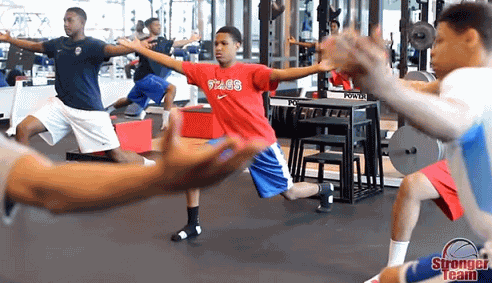How to Condition for Basketball
By Courtney Campbell. The Coach’s Clipboard Basketball PlaybookFrom Courtney Campbell - Courtney Campbell is the owner of Train to Ball and the head strength and conditioning coach for boys basketball at Gainesville High School (Gainesville, Fla.). He earned his bachelor's and master's degrees from the University of Florida, where he served as a graduate assistant strength and conditioning coach, working with basketball, golf and tennis athletes. Follow him on Twitter.
Basketball is played at an extremely high intensity. To play the game to a high level, not only do you need to be a skilful player, but you also need to be physically prepared. Basketball is mostly an anaerobic sport because require a high level of strength, speed and power, but it also requires a high level of cardiovascular conditioning and endurance, as games are played over a relatively long duration, and at a high intensity. As a coach, you need to find the right balance between strength speed and power and also ensure his players are sufficiently conditioned.

- Use science to improve your team.
- Determine the demands of the sport.
Research of game activity of high level players has shown that basketball is played with a work:rest ratio in a basketball game is 1:3.6 (Abdelkrim et al, 2010).
Meaning: This research basically says that for every 1 second of work, a basketball player gets 3.6 seconds of rest.
Another study highlighting the intensity that basketball is played at looked at the heart rate of players during games. They found that approximately 65% of time during a game was at a heart rate greater than 85% of participant’s maximum heart rate. With an average heart rate during games reported at 164.9 bts per min in participants.
Meaning: 65% of the game player’s heart rates are at a high intensity level.
Along with this a study found that a change of event occurs every 3.8 seconds during competitive games (McInnes et al, 1995).
It is reported that players average:
- 105 forward sprints per game
- 114 medium intensity
- 63 high intensity lateral and backward shuffles per game (McInnes et al, 1995).
Meaning: This research clearly highlights that basketball is played at a very high intensity, with lots of short sprints and shuffles.
Action: We need to condition athletes based on the following:
- Base your Conditioning on a 1:3-4 work to rest ratio
- Do not: Focus on Long Endurance training
- Make sure your conditioning is high intensity mimicking game intensity
- Do not forget to condition lateral and backward shuffles in conditioning.
So taking into consideration the research that’s been highlighted, conditioning drills for basketball players should always be performed at a high intensity, and this should always be chosen over long slow runs. This is because for one it is more specific to the demands of basketball and also long endurance training can transfer fast twitch muscle fibres over to slow twitch muscle fibres, this is bad for basketball players because fast twitch fibres are far more explosive in their characteristics when compared to slow twitch muscle fibres.
Idea: A good drill would be sets of 10 seconds of high intensity sprinting, followed by 30 seconds of active rest.
Overall I hope this article shed some light on the conditioning demands of basketball and how they could be met in the most effective and efficient way.
References
McInnes SE, Carlson JS, Jones CE, McKenna MJ. (1995). The physiological load imposed on basketball players during competition. J Sports Sci, 1, 387-397
Abdelkrim B, Castagna C, Jabri I et al. (2010). Activity profile and physiological requirements of junior elite basketball players in relation to aerobic and anaerobic fitness. J Strength Cond Research, 2, 230-232.